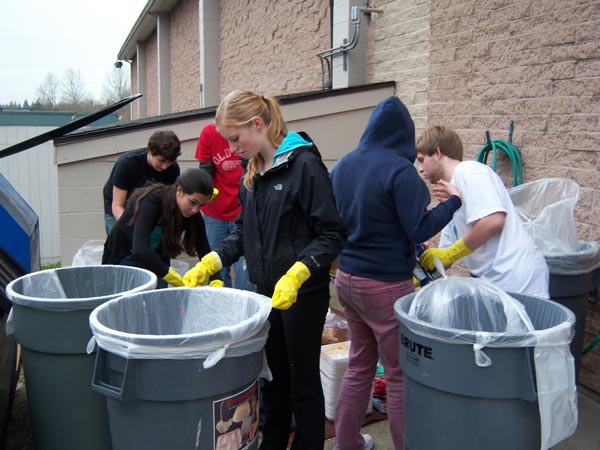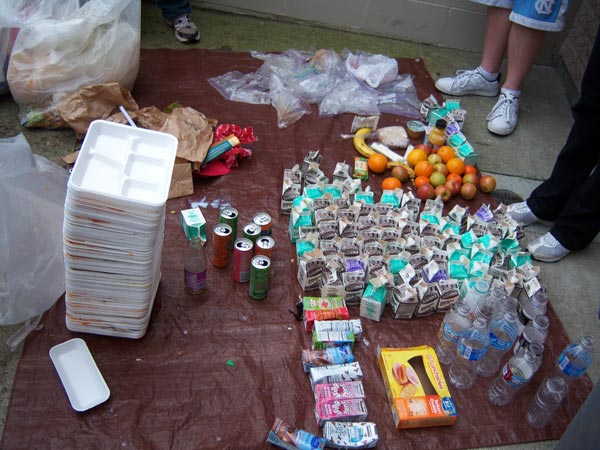Success story: International School
School District: Bellevue
School Location: Bellevue
Began participating in the Green Schools Program: September 2009
Level One of the Green Schools Program: Achieved in May 2010
Level Two of the Green Schools Program: Achieved in April 2011
Level Three of the Green Schools Program: Achieved in April 2012
Waste reduction and recycling (level one)
- The City of Bellevue partnered with the Green Schools Program to assist Bellevue schools with recycling improvements.
- Students created “recycling” and “trash” posters for the cafeteria, handouts to help students learn what can and can’t be recycled, and signs to raise awareness about reducing waste and recycling.
- Student volunteers monitored the cafeteria recycling program, reminding students about what can and can’t be recycled.
- The school held a “Green Week” that included posters and morning announcements to promote recycling and provide recycling facts.
- Students toured the Allied Waste recycling facility to find out how recyclable materials are sorted by the company that provides recycling collection service for the school.
- Student volunteers helped to launch Medina Elementary School’s food scrap recycling program, assisted at elementary school science fairs to raise awareness about stream pollution, and volunteered at an Arbor Day “Zero Waste” station.
- Tips about recycling were shared on the school’s daily news broadcast.


- The City of Bellevue sponsored a recycling booth during lunch.
- Trivia games, presentations and a relay game were used to educate students about recycling and waste reduction.
- All classrooms, offices and the cafeteria have recycling containers.
- During a two-day pilot in April 2010, the school used compostable trays and utensils and then collected food scrap/food soiled paper to be composted.
- Students conducted two garbage audits.
- Many students and staff wore green to promote National Recycling Day in November 2009.
- The school received assistance from the Local Hazardous Waste Management Program in King County and implemented their recommendations in its art room and laboratory.
- In 2010-11, through increased recycling and waste reduction, the school increased its recycling rate from 40 percent to 50 percent, and reduced weekly garbage volume from 18 cubic yards to 12 cubic yards.
- Students started a tray stacking program at lunch.
- Staff applied for three grants to help offset the cost of buying compostable trays
- The green team held a sweatshirt fundraiser to raise money to buy compostable trays.
- The green team collected and donated gently used clothing to Goodwill.
- The green team held a “Green Week” that included making posters and broadcasting morning announcements to promote recycling, and waste reduction.
- Students held drives to recycle batteries, ink carriages, and cell phones.
- Students created a PowerPoint to teach students and staff how to properly sort their lunch waste and stack trays.
- Students monitoring school lunches created a location in the cafeteria where classmates finishing their lunches could sort their recycling and garbage and stack trays.
- During 2011-12, the school increased its recycling rate to 60 percent by reducing waste and continuing to collect recyclable and compostable materials. Students stacked their lunch trays to reduce garbage volume in the dumpster and funds were raised to buy compostable trays for the 2012-13 school year.
- A PowerPoint presentation was played in first period to help educate students about how to sort their lunch into food waste, leftover liquids, recyclable materials, garbage, and tray stacking.
- Posters and morning announcements reminded students how and what to sort at lunch.
- Students monitored lunch stations to help their fellow students sort leftover liquids, recyclable materials, and garbage into the correct containers.
Energy conservation (level two)
- The school presented its energy use data at a staff meeting along with a list of suggestions to reduce energy use. Staff members received follow up emails reminding them to reduce energy use.
- Students audited the carbon emissions of 16 classrooms and submitted suggestions for reducing carbon emissions for each classroom.
- Students and staff calculated their carbon footprints.
- From September through December 2010-11, International School reduced energy use by 17 percent due to energy conservation practices and reduced heating temperature requirements from the school district.
- Tips about reducing energy use were shared on the school’s daily news broadcast.
- The green team shared energy conservation tips during morning announcements and in monthly staff meetings.
- Students placed energy conservation labels near all light switches and near electrical equipment in the school.
- Students calculated their carbon footprints to evaluate their energy use.
- Tenth grade students participated in the “Be the Solution” workshop from Nature Vision.
- Students created a PowerPoint presentation to promote using power strips and held a drive to collect power strips for classroom use because all equipment plugged into one power strip can easily be turned off.
- The green team shared the school’s annual energy use with staff.
- School staff added energy saving tips to the schools website.
- The green team held a “Green Week” that included making posters and broadcasting morning announcements to promote energy conservation.
Water conservation and pollution prevention (level three)
- Classes participated in the “Powerful Choices” program which includes energy and water conservation lessons.
- Lead custodian adjusted all faucets to decrease water waste.
- The green team used the water conservation resource tub materials from the City of Bellevue.
- On Water Conservation Wednesdays, the school made weekly morning announcements consisting of water conservation tips and facts.
- To help reduce water consumption, posters and stickers were placed near faucets in classrooms, bathrooms, and other sinks throughout the school.
- Received two grants totaling $1,500 (after last year’s success story): Terry Husseman Sustainable School Award and the Mother House Fund Seeds of Compassion.
- The school held a pledge campaign to stop buying bottle water.
- Announced annual water consumption with tips for reducing water consumptions via staff meeting (staff), mourning announcements (students), and the Monday Messenger (parents.)
- Made a water conversation video with information on why it is important to converse water, along with tips on how to converse water.
- Sixth grade students calculated their carbon footprint.
For more information about the school’s conservation achievements and participation in the Green Schools Program, contact:
International School
425-456-6500


 Translate
Translate
